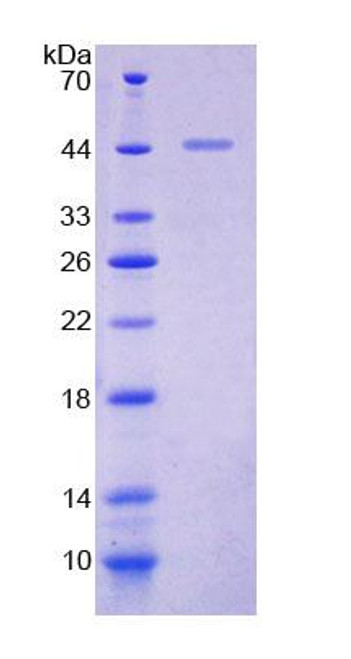Product Description
Human Glycogen debranching enzyme (AGL) ELISA Kit | AE24260HU | Abebio
Species Reactivity: Human (Homo sapiens)
Abbreviation: AGL
Alternative Name: GDE; OTTHUMP00000012504|amylo-1;6-glucosidase; 4-alpha-glucanotransferase|glycogen debranching enzyme
Application: ELISA
Range: 31.25-2000 pg/mL
Sensitivity: 15.2 pg/mL
Intra-Assay: ≤5.9%
Inter-Assay: ≤9.8%
Recovery: 0, 93
Sample Type: Serum, Plasma, Other biological fluids
Detection Method: Sandwich
Analysis Method : Quantitive
Test Principale: This assay employs a two-site sandwich ELISA to quantitate AGL in samples. An antibody specific for AGL has been pre-coated onto a microplate. Standards and samples are pipetted into the wells and anyAGL present is bound by the immobilized antibody. After removing any unbound substances, a biotin-conjugated antibody specific for AGL is added to the wells. After washing, Streptavidin conjugated Horseradish Peroxidase (HRP) is added to the wells. Following a wash to remove any unbound avidin-enzyme reagent, a substrate solution is added to the wells and color develops in proportion to the amount of AGL bound in the initial step. The color development is stopped and the intensity of the color is measured.
Product Overview: Debranching enzymes are responsible for transferring three glucose subunits of glycogen from one parallel chain to another. Afterwards, the donator branch will contain only one glucose residue with alpha-1, 6 linkage. This remaining residue is in turn cut by alpha-1, 6 glucosidase. This two step process is the general process by which the debranching enzymes "straighten out" glycogen into an unbranched glucose polymer.This enzyme has two independent catalytic activities which occur at different sites on the protein: a 4-alpha-glucotransferase activity and a amylo-1, 6-glucosidase activity. Mutations in this gene are associated with glycogen storage disease although a wide range of enzymatic and clinical variability occurs which may be due to tissue-specific alternative splicing.
Stability: The stability of ELISA kit is determined by the loss rate of activity. The loss rate of this kit is less than 5% within the expiration date under appropriate storage condition. The loss rate was determined by accelerated thermal degradation test. Keep the kit at 37°C for 4 and 7 days, and compare O.D.values of the kit kept at 37°C with that of at recommended temperature. (referring from China Biological Products Standard, which was calculated by the Arrhenius equation. For ELISA kit, 4 days storage at 37°C can be considered as 6 months at 2 - 8°C, which means 7 days at 37°C equaling 12 months at 2 - 8°C) .
 Euro
Euro
 USD
USD
 British Pound
British Pound
 NULL
NULL












